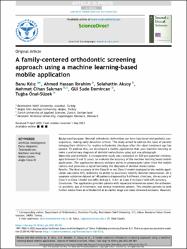A family-centered orthodontic screening approach using a machine learning-based mobile application

View/
Date
2023Author
Kılıç, Banuİbrahim, Ahmed Hassan
Aksoy, Selahattin
Sakman, Mehmet Cihan
Demircan, Gül Sude
Önal-Süzek, Tuğba
Metadata
Show full item recordCitation
B. Kılıc ̧, A.H. _Ibrahim, S. Aksoy et al., A family-centered orthodontic screening approach using a machine learning-based mobile application, Journal of Dental Sciences, https://doi.org/10.1016/j.jds.2023.05.001Abstract
Background/purpose: Skeletal orthodontic deformities can have functional and aesthetic consequences, making early detection critical. This study aimed to address the issue of parents bringing their children for routine orthodontic checkups after the ideal treatment age has passed. To address this, we developed a mobile application that uses machine-learning to make a preliminary diagnosis of skeletal malocclusion using just one photograph. Materials and methods: A retrospective study was conducted on 524 pre-pubertal children, aged between 5 and 12 years, to evaluate the accuracy of the machine learning based mobile application. The application detects multiple points in photographs taken from the mobile camera and generates a signal indicating the diagnosis of skeletal malocclusion. Results: The final accuracy of the Class III vs not Class III model deployed to the mobile application was above 81%, indicating its ability to accurately identify skeletal malocclusion. On a separate validation dataset of 145 patients diagnosed by 5 different clinicians, the accuracy of Class II vs Class I model was 69%; And pg 4, ln 61: as Class II vs Class I with 69% accuracy. Conclusion: The application provides parents with important information about the orthodontic problem, age of treatment, and various treatment options. This enables parents to seek further advice from an orthodontist at an earlier stage and make informed decisions. However, the diagnosis should still be confirmed by an orthodontist. This approach has the potential to improve access to orthodontic care, especially in underserved communities

















